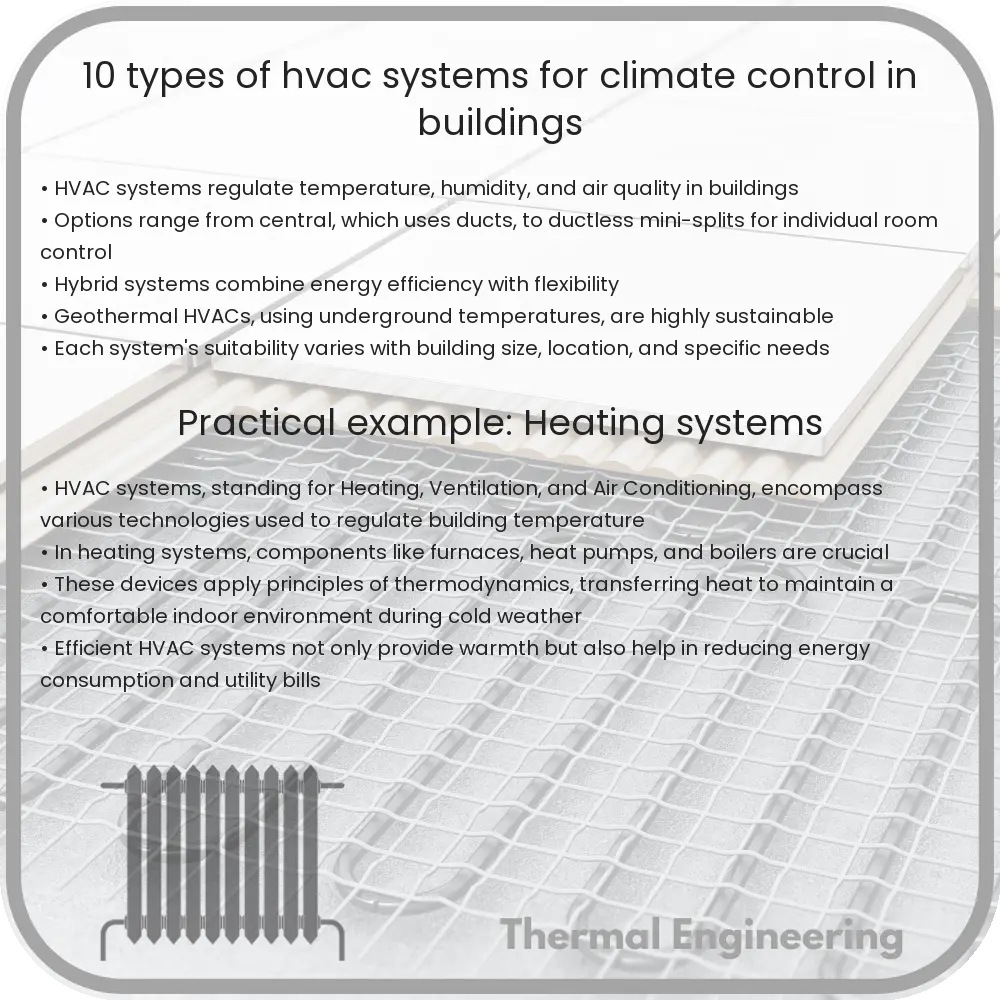Learn about HVAC systems: Heating, Ventilation, and Air Conditioning technology for maintaining indoor climate and air quality.

Introduction to HVAC Systems
HVAC stands for Heating, Ventilation, and Air Conditioning. It is a technology used for maintaining a comfortable indoor climate and proper air quality in buildings. Different types of HVAC systems cater to various building sizes, environmental conditions, and energy requirements. Here we will explore ten common types of HVAC systems used in residential, commercial, and industrial buildings.
1. Single Split System
The single split system is one of the most popular types of HVAC systems due to its affordability and simplicity. This system is ideal for small commercial buildings, offices, and residential areas. It consists of one indoor unit (air handler) and one outdoor unit (condenser), and it allows for individual room control, which provides a cost-effective and efficient way to regulate temperature.
2. Multi-Split System
Similar to the single split system, the multi-split system connects multiple indoor units to a single outdoor unit. This setup helps in reducing outdoor space usage and is effective in environments where limited outdoor space is available. It’s a common choice for restaurants, offices, and multi-family homes, allowing different rooms to be conditioned independently.
3. Variable Refrigerant Flow (VRF) or Variable Refrigerant Volume (VRV)
Often used in medium to large spaces like commercial buildings, hotels, and retail spaces, VRF or VRV systems offer highly efficient energy use and control. These systems use refrigerant as the cooling and heating medium, and the volume of refrigerant can be varied precisely to meet the specific demand of different areas.
4. Heat Pump Systems
Heat pumps are known for their dual functionality. During colder months, they function like a typical heater, extracting heat from the outside and moving it indoors. In warm months, the process reverses. Heat pumps are particularly energy-efficient and environmentally friendly, especially those utilizing ground sources.
5. Geothermal Heat Pump Systems
Geothermal heat pumps are a type of heat pump system that leverages the stable underground temperature to provide heating and cooling. By circulating water through underground pipes, they are extremely efficient and have low operating costs, although the initial installation cost can be higher due to the need for drilling.
6. Ductless Mini-Split Systems
Ideal for spaces where conventional ducted systems are not feasible, ductless mini-split systems provide an effective and scalable way to add air conditioning or heating to specific rooms or areas. These are great for home additions, new constructions, or buildings where ductwork installation is restrictive or impossible.
7. Packaged Heating & Air Conditioning System
Packaged systems contain the evaporator, condenser, and compressor in a single unit, typically placed on a roof or a concrete slab near the foundation. These are particularly common in small commercial buildings with limited space for indoor HVAC components.
8. Hybrid Systems
Hybrid systems use a combination of a heat pump system capable of using electric resistance and gas-fired heating. This adaptability allows the hybrid system to switch between energy sources, optimizing energy use and operational costs based on external temperatures and energy prices.
9. Central Air Conditioning Systems
Used primarily in larger homes or sizable commercial buildings, central air conditioning systems distribute cooled air through a system of ducts and registers. This system can be paired with a furnace or heat pump and includes components housed both outside and inside the building.
10. Evaporative Coolers
Also known as swamp coolers, evaporative coolers are suitable for hot, dry climates. They cool the air by evaporating water, which naturally cools the air and increases humidity. These systems are more energy-efficient than conventional air conditioning systems in appropriate environments.
Conclusion
Understanding the different types of HVAC systems is crucial in selecting the right system for a building’s specific needs while balancing factors such as climate, building size, and energy efficiency. Choosing the appropriate HVAC system can lead to enhanced comfort, reduced energy costs, and better air quality.